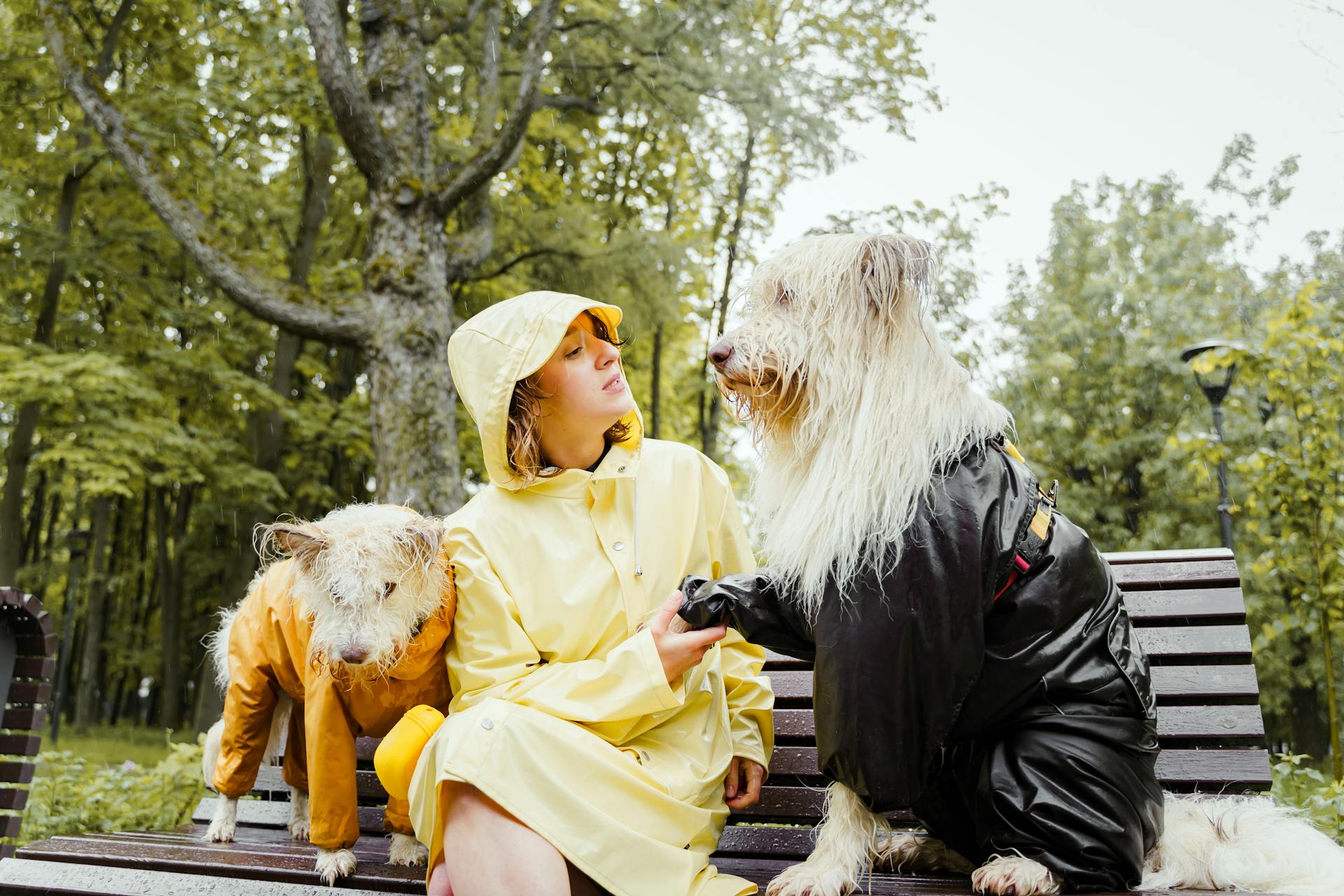
Service dogs are highly trained animals that assist individuals with disabilities, and adopting one can be a life-changing experience.
These dogs are trained to perform specific tasks, such as opening doors, picking up items, and providing balance support, to help their handlers navigate daily life.
Service dogs can be a great fit for people with mobility issues, visual impairments, or mental health conditions, as they provide emotional support and physical assistance.
In the United States, service dogs are protected under the Americans with Disabilities Act, which prohibits discrimination against individuals with disabilities and their service animals.
Curious to learn more? Check out: Are Service Animals Only Dogs
Service Dog Adoption Process
Adopting a retired service dog can be a long process, with many organizations having waitlists that are several years long. These waitlists require extensive screening for potential adoptees, so it's essential to be patient.
You'll need to find and work with local organizations that help rehome retired and career-change dogs. This can help make your name stand out, such as volunteering with or donating to that organization.
Some organizations, like Guide Dogs of America, work specifically with service dogs and their handlers. If you're considering adoption, it's best to know someone looking to rehome their service dog, as this can shorten the wait time.
Recommended read: How Long Does It Take to Train Service Dogs
Benefits and Considerations
Adopting a retired service dog can be a wonderful experience for both you and the dog. These dogs are often exceptionally intelligent and good-tempered.
They may retain a lot of their training and be able to perform specific tasks, making them excellent pets.
You're not alone in considering adoption - many organizations and rescues have waiting lists for these retirees.
Service animals often form close bonds with their handlers, but sometimes it's not possible for handlers to keep their pup after retirement.
These career-change pups may not be suited for the life of a service dog, but they do make excellent pets.
In some cases, dogs don't make it through their initial training due to reasons like not getting along with other animals or having high energy levels.
Suggestion: How to Make Dogs Service Animals
Service Dog Training and History
Service dogs have a rich history that dates back to ancient times. They've been used for various purposes, including hunting, herding, and companionship.
The use of service dogs as assistance animals for people with disabilities has its roots in the 16th century, when dogs were first used to help blind individuals navigate.
The Americans with Disabilities Act (ADA) of 1990 recognized the importance of service dogs and provided guidelines for their use in public places.
Service dogs undergo rigorous training to learn specific tasks that aid their handlers, such as opening doors, picking up items, and providing emotional support.
Broaden your view: Ada Rules on Service Dogs
Training Process
Retired service dogs are usually very well-trained, often having the basics down, and may not even need leash or potty training.
The training process for these dogs is often less intensive, as they've already learned the fundamentals.
Career-change dogs that didn't make it through service animal training are still highly trainable, and can pick up where they left off.
In some cases, the training process can be as short as a few weeks, allowing the dog to quickly adapt to their new role.
The Elite Complete Training Program, for example, takes approximately four months to complete, with a specific rotation of trainers and owners that helps the dog learn and bond with their new handler.
Known History
Adopting a retired service dog can be a wise decision due to their known history.
Normally, adopting a dog that's been surrendered to a rescue comes with financial risk, as you don't know their full medical history.
These dogs have been in training since puppyhood and are often in relatively good health.
They come with medical documents such as vaccination records and information on existing health issues.
Their behavior and temperament are well-documented, giving you a clear idea of their personality.
Curious to learn more? Check out: How Does Adopting a Dog Work
Service Dog Organizations and Adoption
If you're considering adopting a service dog, you'll want to reach out to reputable organizations like Assistance Dogs International, Canine Companions for Independence, Dogs for Better Lives, and Paws 4 People.
These organizations often have a waitlist, with Guide Dogs for America having a six-year waiting list. Be prepared to wait, as it's not uncommon for organizations to have a long waiting period.
You can also check with other organizations like Dogs Without Borders, Service Dogs, Inc., and Service Dogs by Warren Retrievers if you don't find a dog to adopt with the initial organizations.
For another approach, see: Psychiatric Service Dog Organizations
Organizations That Train
If you're looking to adopt a service dog, there are several organizations that can help you find the perfect companion.
Some organizations that train service dogs and may have retired or available dogs include Assistance Dogs International, Canine Companions for Independence, Dogs for Better Lives, and Paws 4 People.
You can also check with Dogs Without Borders, Service Dogs, Inc., and Service Dogs by Warren Retrievers, although be prepared for a wait.
Guide Dogs for America has a six-year waiting list and is not taking new applications, so it's best to explore other options first.
Service dog training organizations often have partnerships with shelters and may pull dogs from overcrowded facilities, like the partner municipal shelter that helped find Miss B.
Placement
Service dog organizations have a process in place for rehoming retired service dogs. Many organizations, such as Guide Dogs of America, have waitlists that are several years long due to high demand.
You can inquire with organizations like Assistance Dogs International, Canine Companions for Independence, and Paws 4 People to see if they have any retired service dogs available for adoption. Be prepared to wait, as some organizations have waitlists that are years long.
Some organizations, like Service Dogs, Inc., and Service Dogs by Warren Retrievers, also have retired service dogs available for adoption. You can also check with local groups in your area, as they often have a more streamlined process.
Dogs that don't make it through service dog training may be adopted by loving families through programs like PPP's Paroled Pet Program. These dogs are often exceptionally intelligent and good-tempered, and may retain some of their training.
In some cases, service dog organizations may work with partner shelters to find homes for retired service dogs, as happened with Miss B, who was adopted by Naval veteran Aimee.
For your interest: Retired Service Dogs for Adoption
Service Dog Adoption Options
You can consider adopting a service dog dropout, as these dogs are well-socialized, respond well to commands, and behave well in public. They may have lacked a critical skill for specialized service work, but they can make loyal and helpful companion dogs.
Some organizations maintain separate lists for failed service dogs, so it doesn't hurt to ask. You can also inquire at your local police, fire, and emergency services departments.
Retired service dogs are also in high demand, and many organizations have waiting lists. They're often exceptionally intelligent and good-tempered, and may retain some of their training.
Finding a Right Choice for You?
Retired service dogs have worked hard and deserve a good fur-ever home. They make wonderful pets and tend to form strong bonds with their families.
Going to a new home can be difficult for these dogs at first because of the deep attachment they had with their former handler. With time, they open up and bond with their new family.
If you can’t commit to keeping the dog for the rest of its life, a retired service dog isn’t a good choice for you. This means being prepared to care for the dog for its entire life, which can be up to 12-15 years or more.
For more insights, see: Home Euthanasia Service for Dogs
Career-change dogs are often young adults and highly intelligent, so you should be prepared to keep them mentally stimulated. This can include providing regular exercise, training, and playtime.
It's essential to find out why a career-change dog had to change careers and if that is an issue you are equipped to work with. This will help you determine if the dog is a good fit for your lifestyle and needs.
Many organizations that help rehome retired and career-change dogs prefer to keep things local, so it’s best to find and work with groups in your area. This can also help you get a sense of the dog's personality and needs before adopting.
For your interest: Dog Work
Adoption Costs
The cost of adopting a retired service dog typically runs $200 to $500.
You may be able to adopt a dog for a lower fee if the referring organization's kennels are full.
A rescue organization may ask for more to ensure the dog goes to new owners who can afford to keep it.
If you live in California, your adopted dog will need a checkup with the vet.
All the dog's immunizations should be up to date, and you'll need to have a bed, toys, food and water bowls, and pet food on hand.
It's a good idea to carry pet insurance on all the animals you adopt.
Recommended read: Do Service Dogs Need to Be Registered
Military Service Dogs
Military Service Dogs can be adopted through organizations that specialize in rehoming career-change dogs. These organizations often work to find homes for retired and failed working dogs, including military working dogs.
Some organizations, like Mission K9 Rescue, focus on rehoming military working dogs that are no longer needed for service. They work to match these dogs with suitable applicants.
Mission K9 Rescue, for example, works to find homes for retired and failed working dogs, including military working dogs.
Worth a look: Foster Dogs for Military
Frequently Asked Questions
What are failed service dogs called?
Failed service dogs are often referred to as having a "career change" rather than being considered failures. They're simply transitioning to a new line of work that suits their skills.
What happens if a service dog fails?
If a service dog fails training, it may be adopted out by a national dog organization as a "career change dog" to become a pet. These dogs can make wonderful companions for families who are willing to provide a loving home.
What happens to failed seeing eye dogs?
Failed Seeing Eye dogs are rehomed through our dog adoption program or can be kept as pets. Learn more about our training process and adoption options on our website.
Why do dogs flunk out of service dog training?
Dogs may flunk out of service dog training due to issues like nervousness, physical ailments, or distractions. Training can be lengthy, but it's not uncommon for dogs to not meet the qualifications for service work.
What breed Cannot be a service dog?
No breed of dog can be excluded from being a service animal, regardless of breed-specific bans or fears. Service animals may be any breed of dog, as long as they are individually trained to perform a specific task.
Sources
- https://www.petassure.com/maxscorner/how-to-adopt-a-retired-service-dog/
- https://www.servicedogregistration.org/blog/how-to-adpot-retired-service-dog/
- https://www.prisonpetpartnership.org/placement-and-adoption
- https://www.northshorehumane.org/shelter2service
- https://www.guidedogsofamerica.org/adoption/
Featured Images: pexels.com


